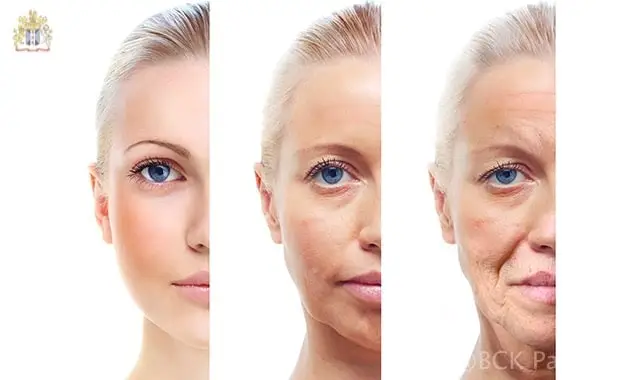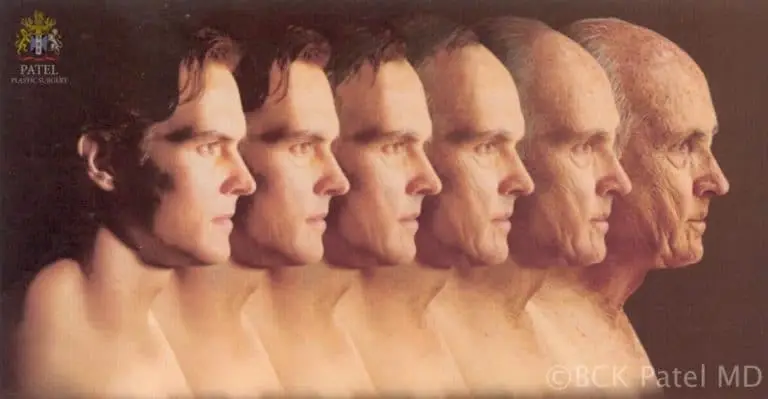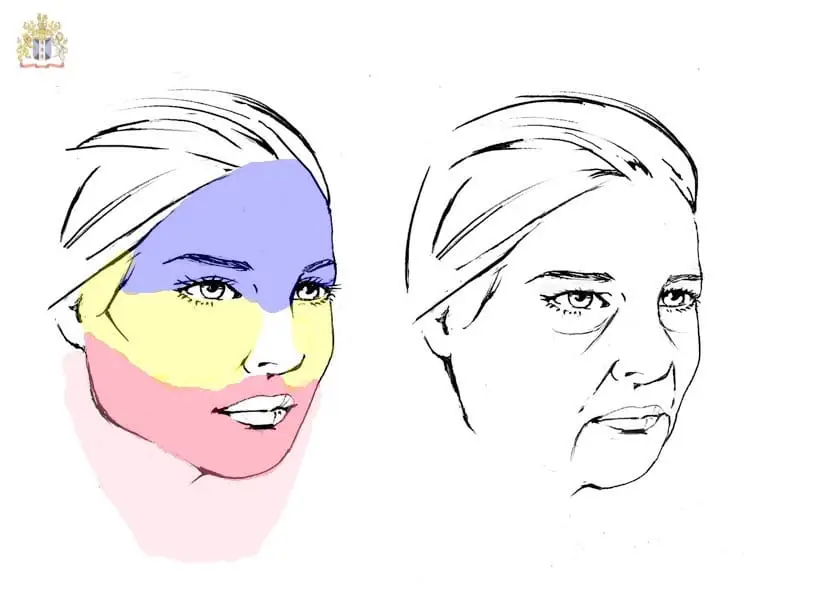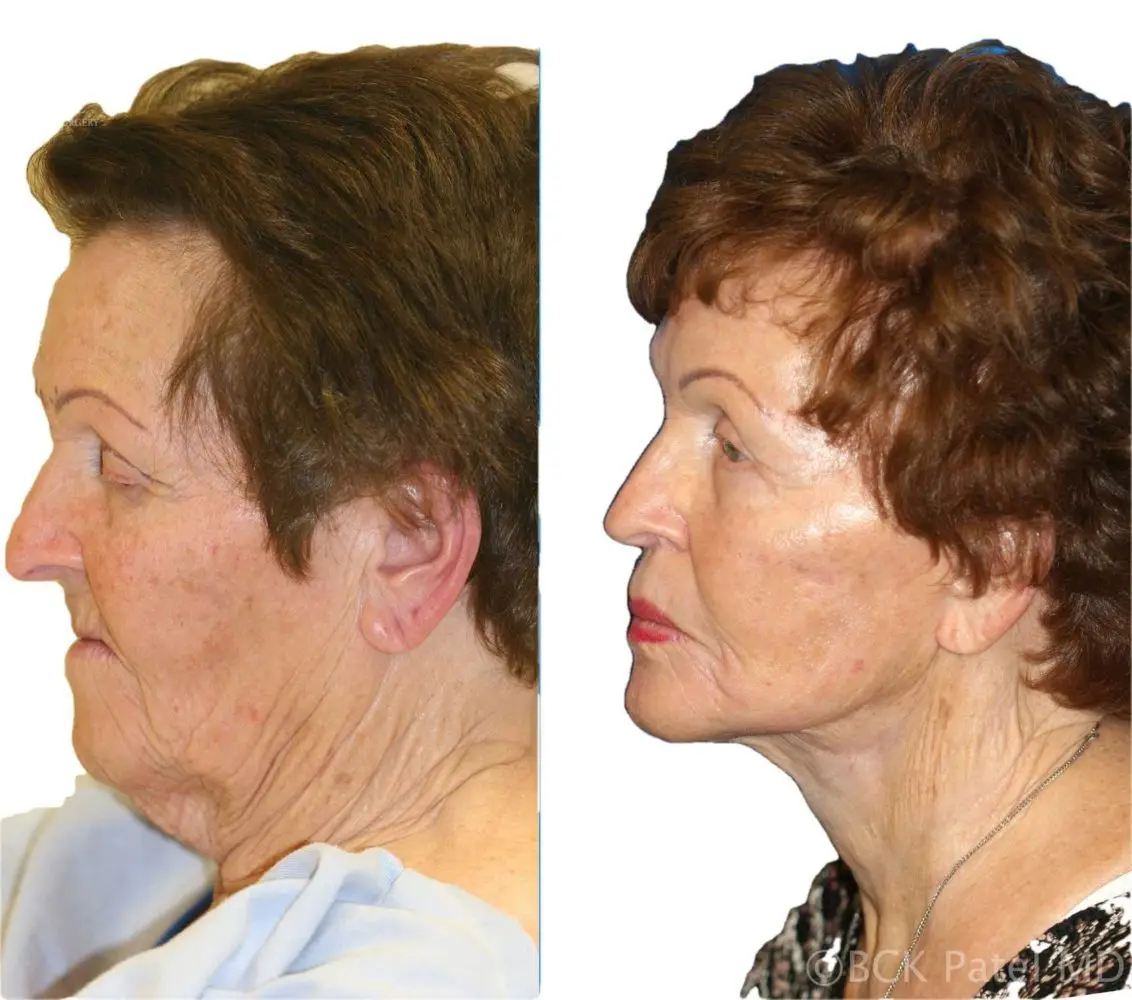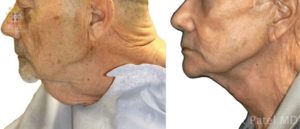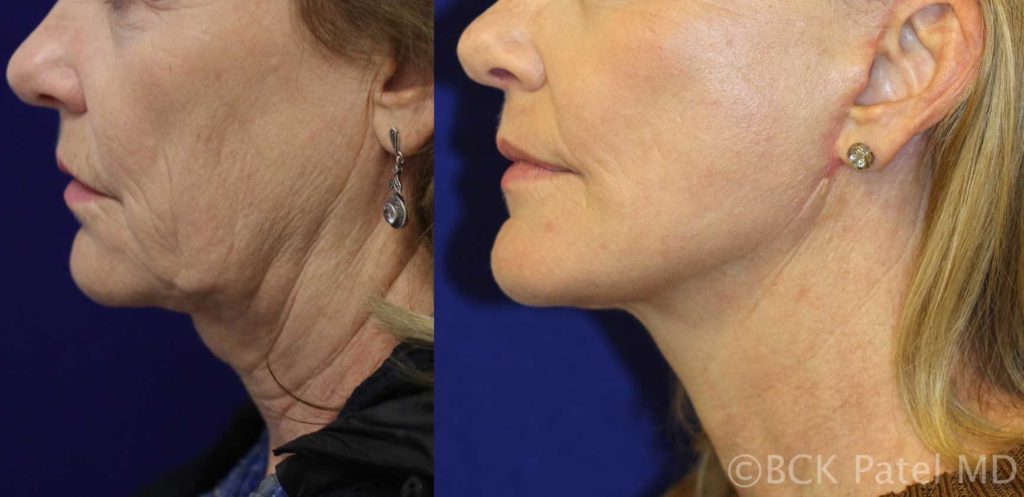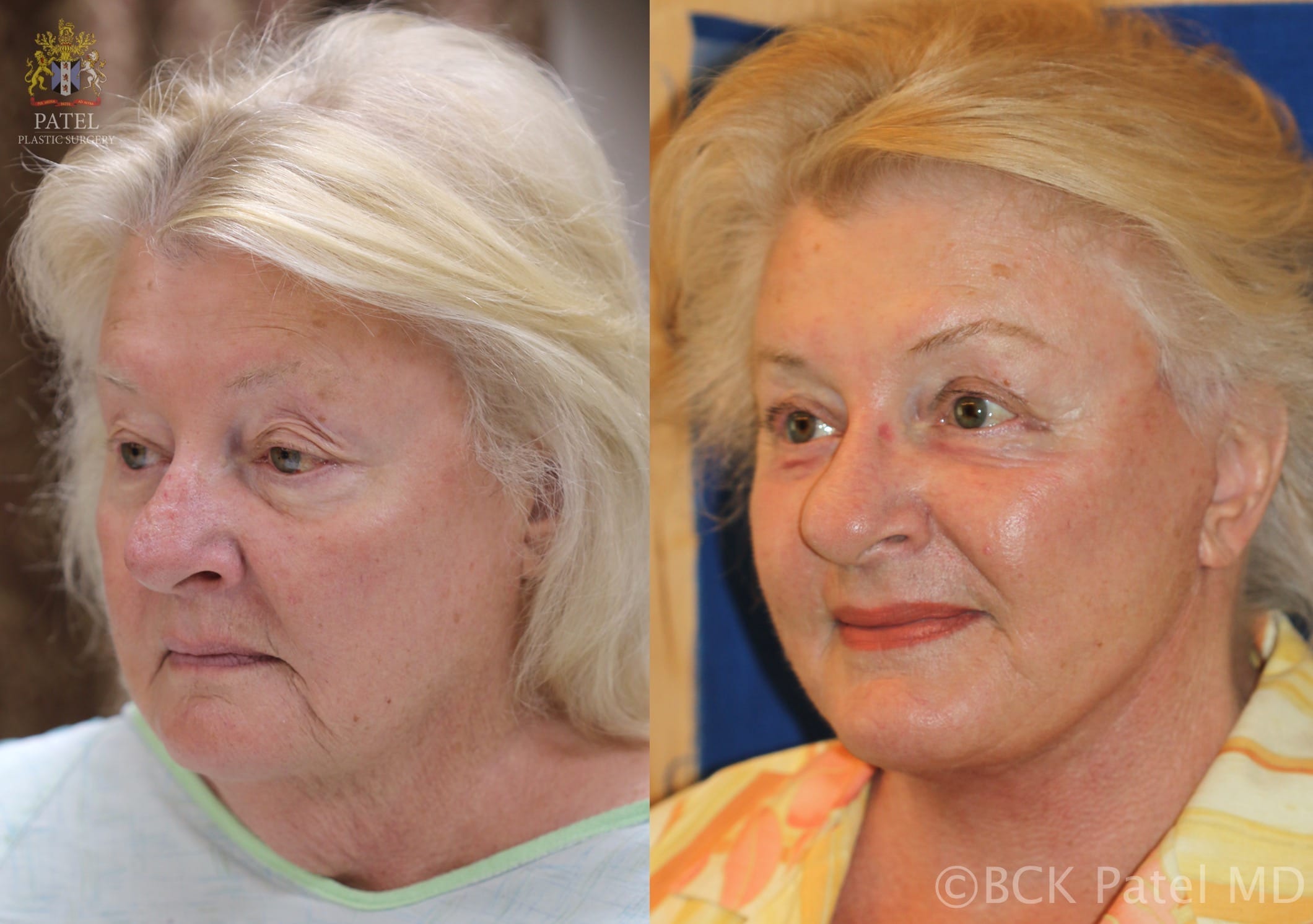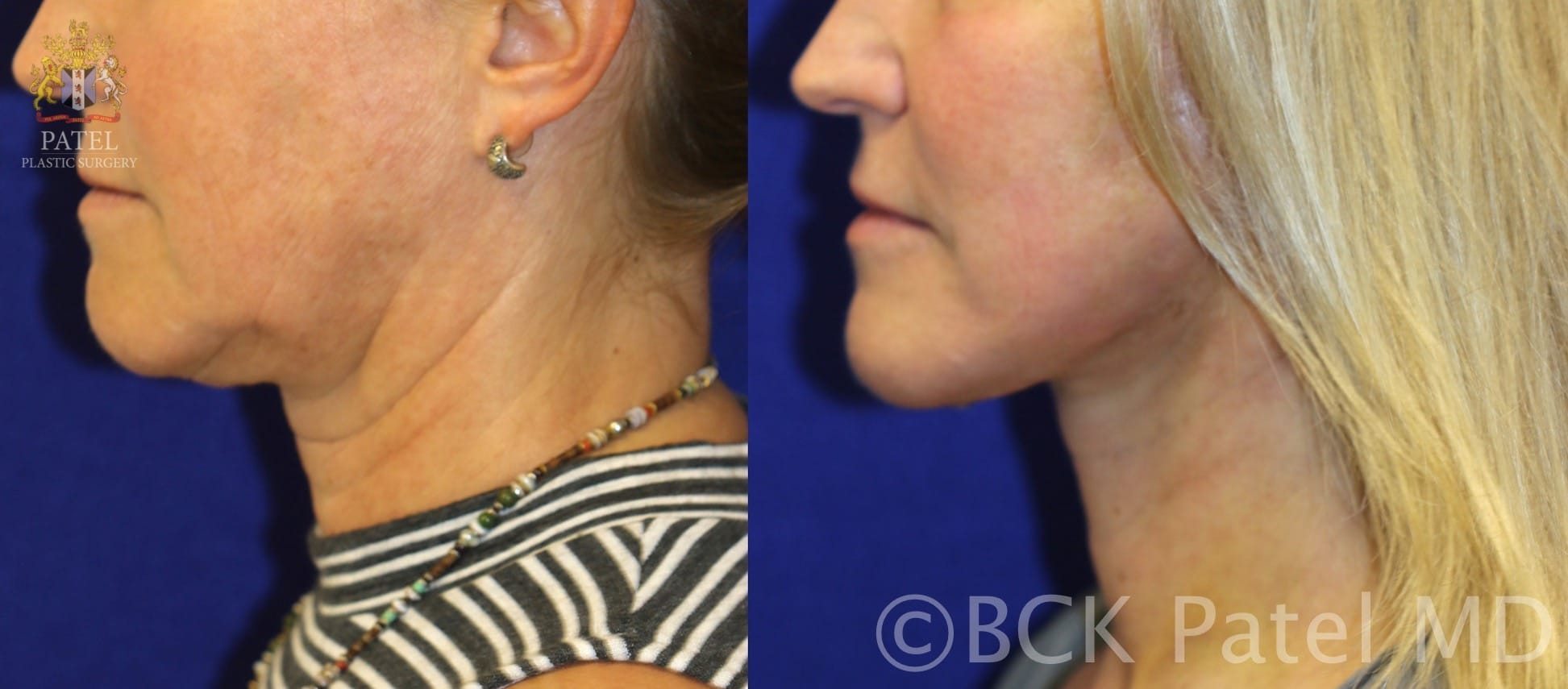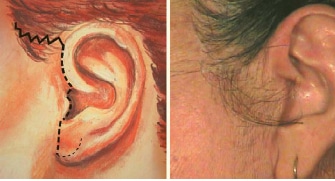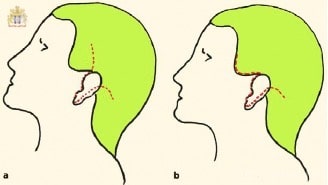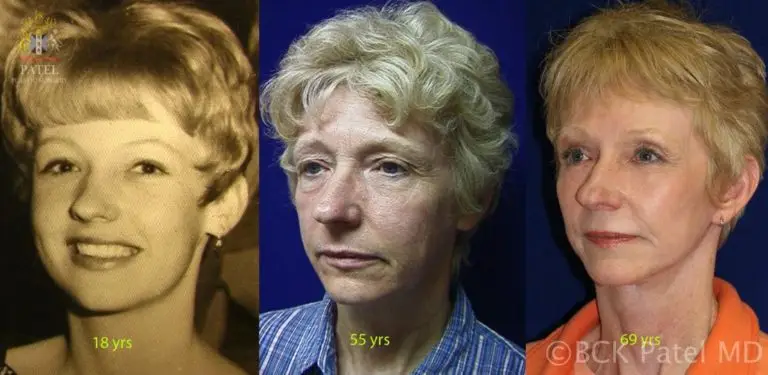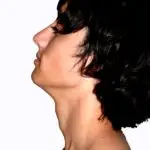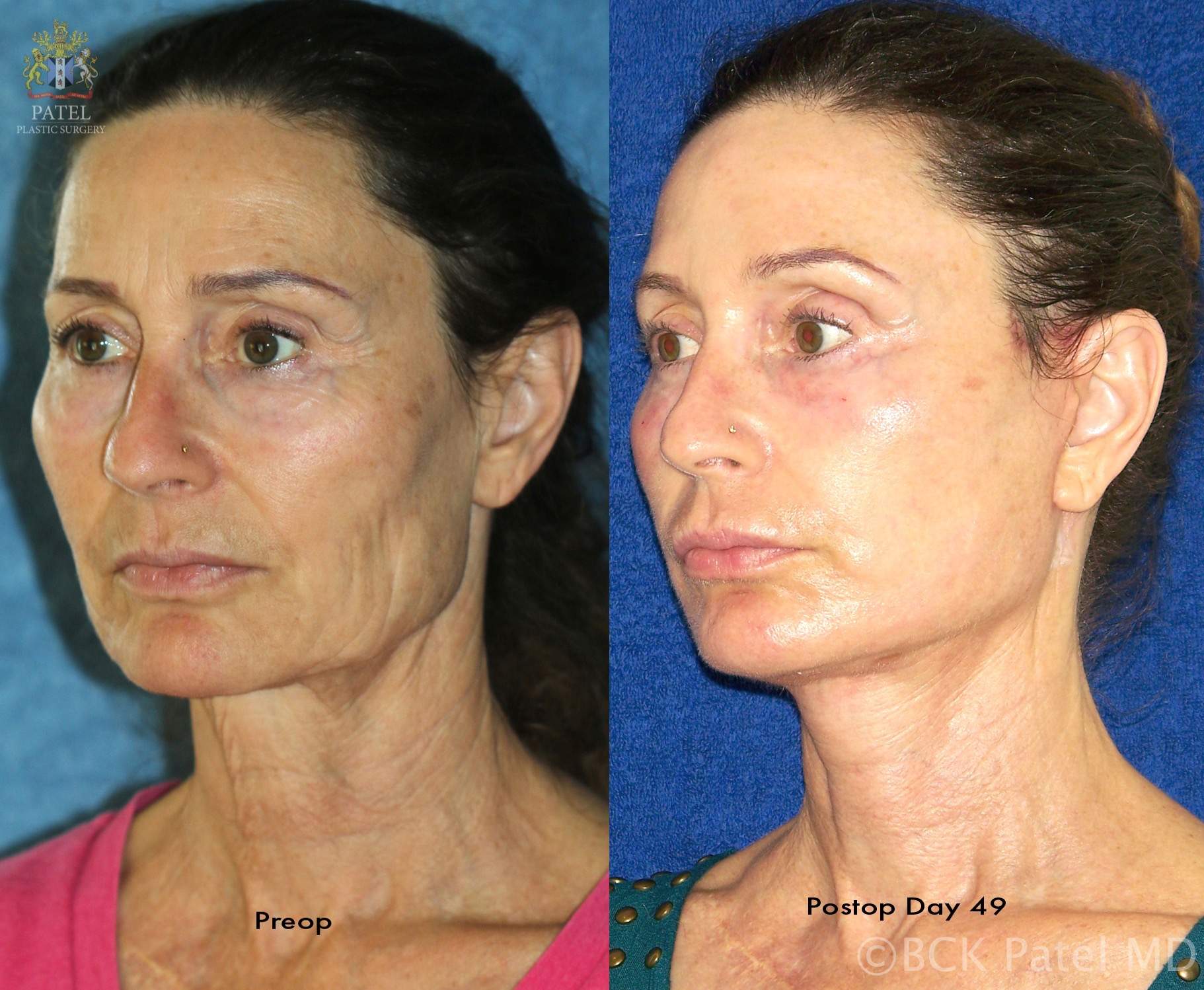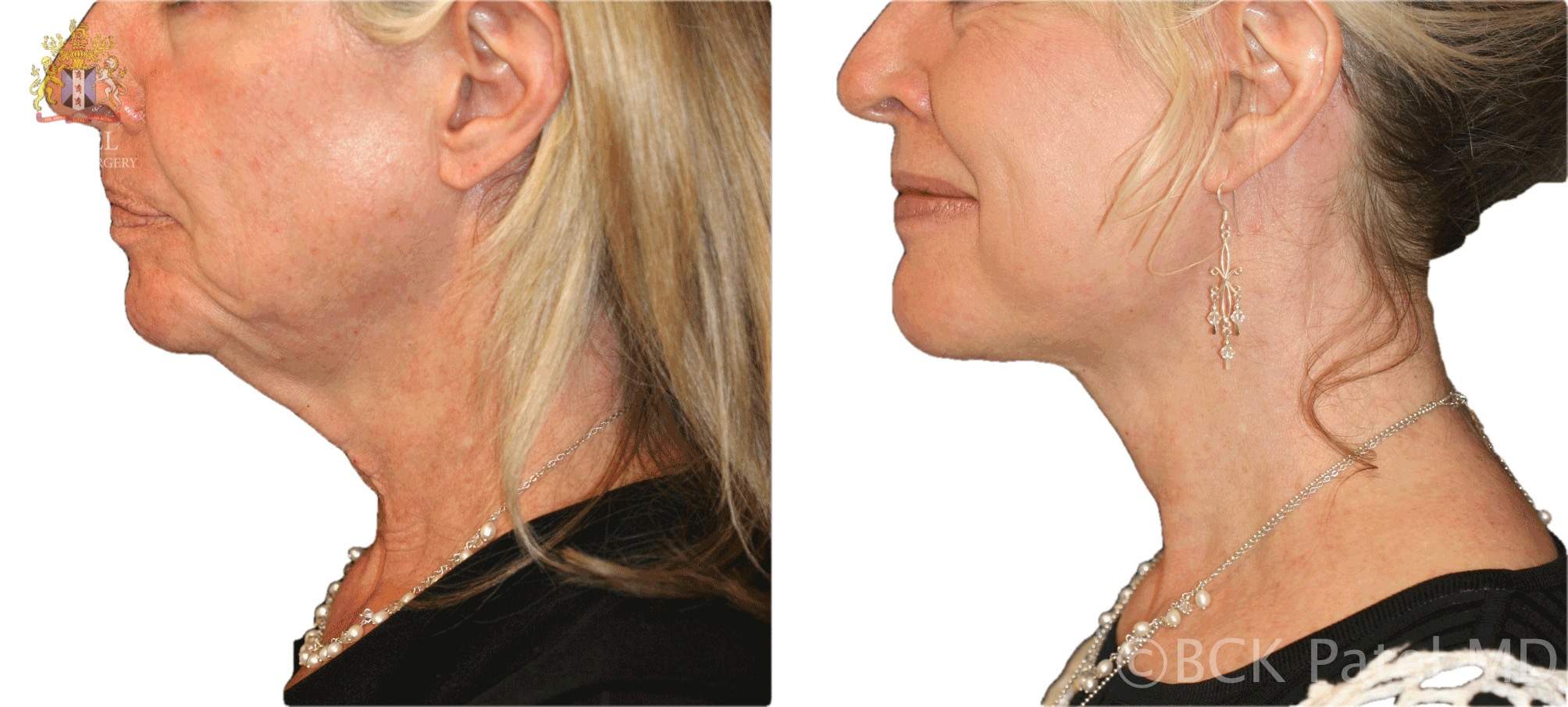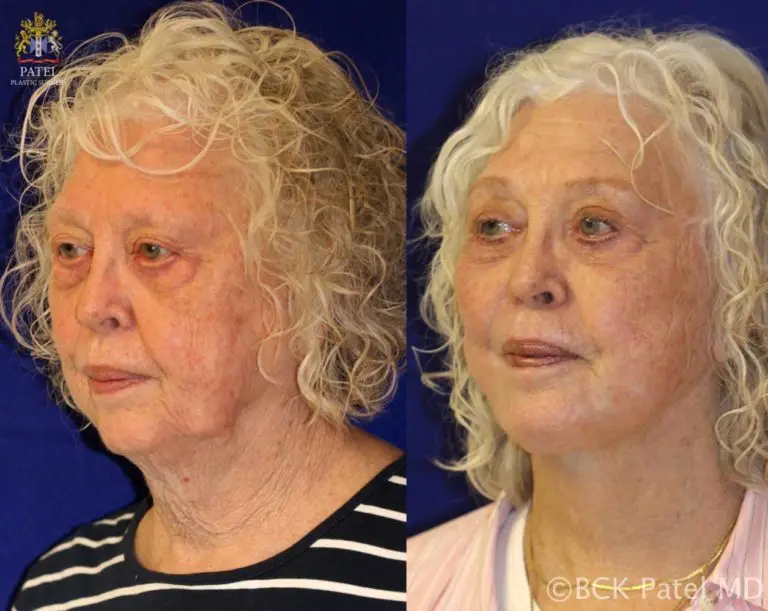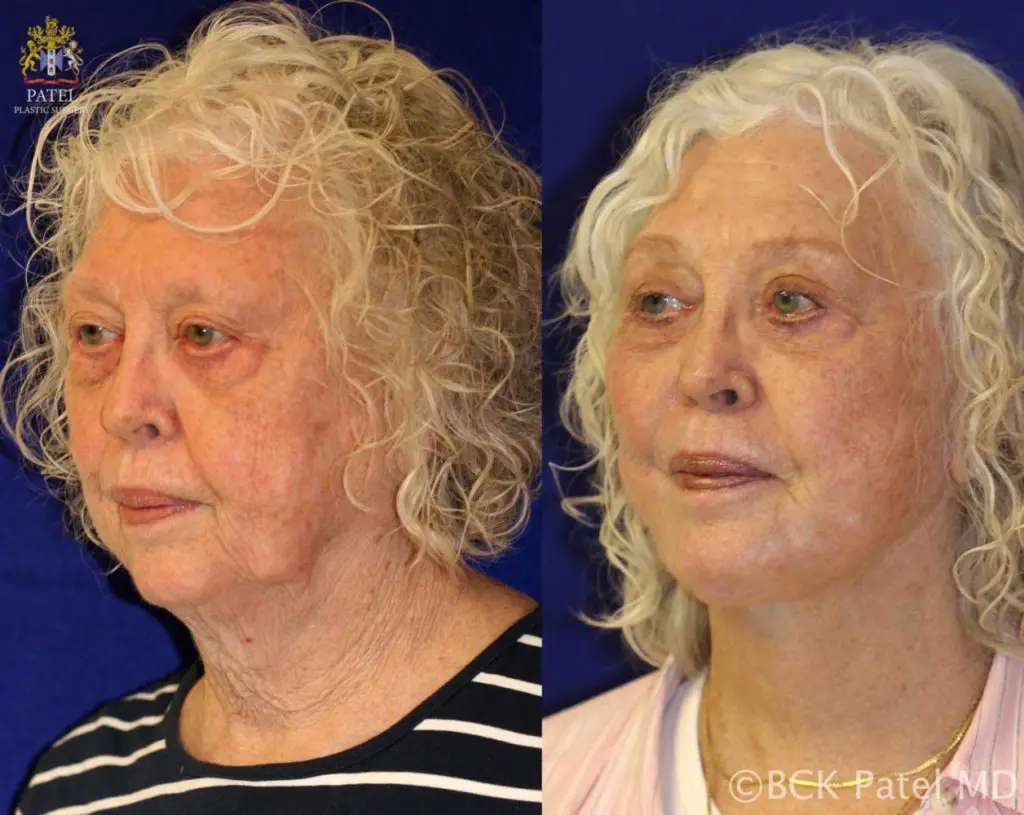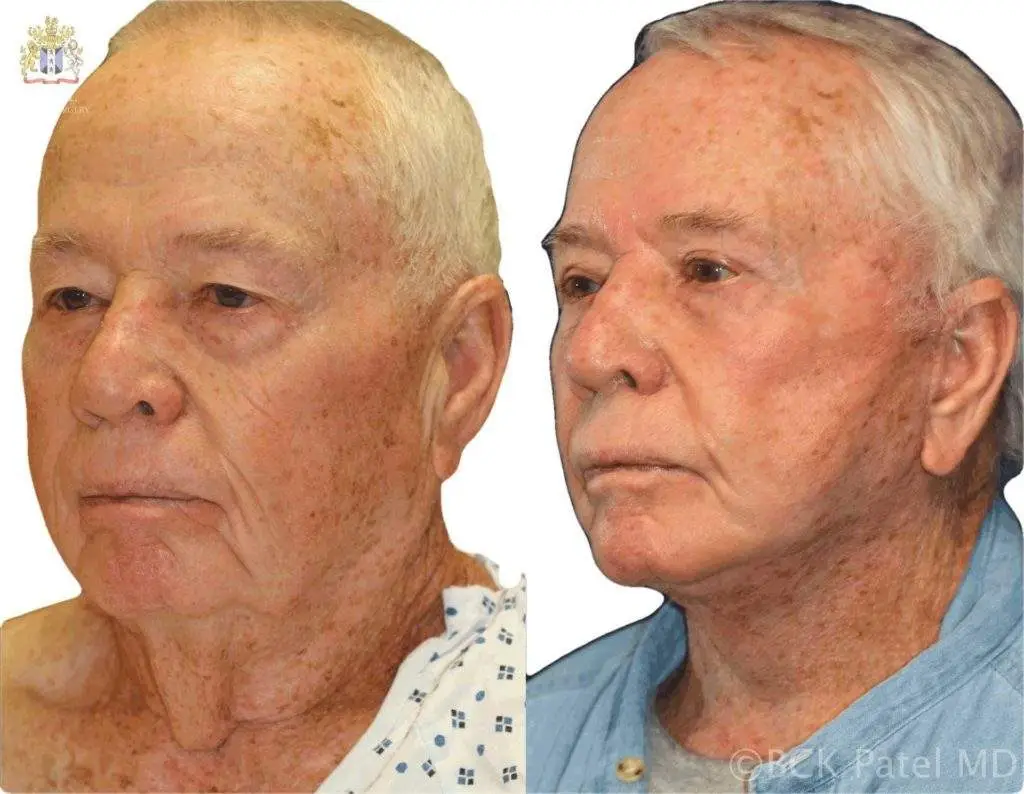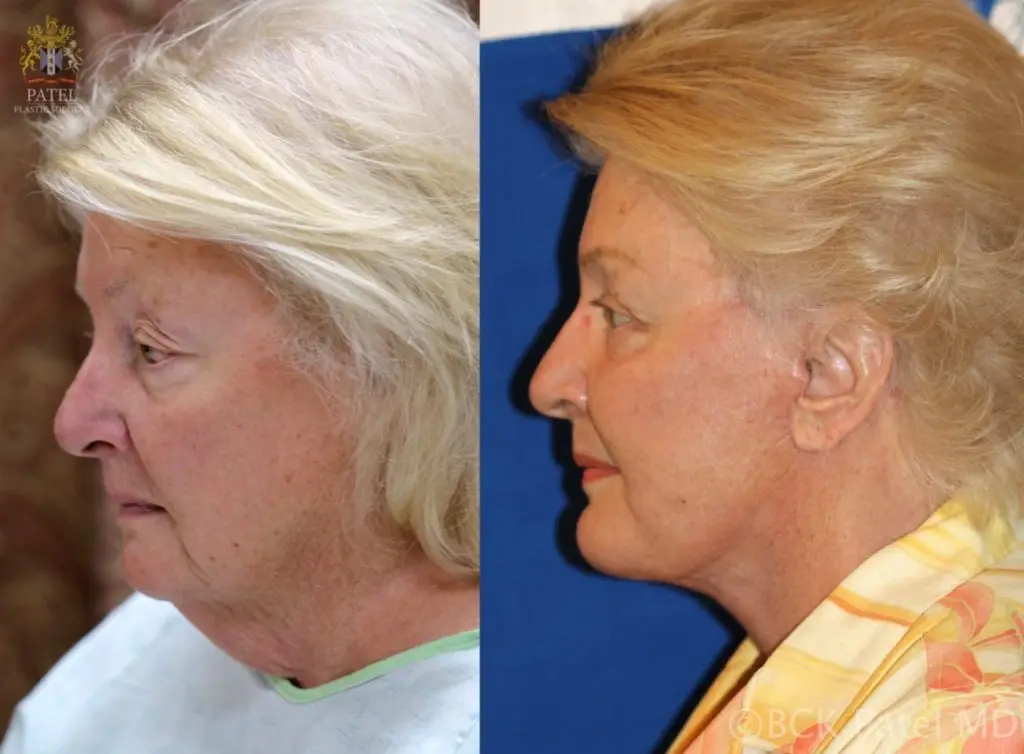Facelifts
Facelifts are known by many different names: rhytidectomy, facelift, cervico-facial lift, face-and-necklift, lower facelift, etc. Then there are many gimmicky names that are designed to sell the procedure to the public and are best avoided. There is no such thing as a “weekend lift”, “no-scar facelift”, “quicko-facelift”, “acme facelift”, etc. These are creations of the slick advertising surgeon, all too common and best avoided at all costs.
Tempus fugit: aging of the face is inevitable and inexorable. Or as Hippocrates so succinctly put it: “ars longa, vita brevis”. With the steady march of time, there is loosening of skin, tendons, deeper supporting structures as well as changes in bones, resulting in the well-recognized changes of aging that affect our face and neck. From forehead lines and creases, to drooping brows and eyelids, to crow’s feet to deep nasolabial and melolabial folds, to jowls, to loss of the jawline, to double and triple chins to neck laxity and bands. And that is just a brief outline of aging, the full discussion of which would take a textbook to discuss. It affects ladies and chaps with equal remorseless persistence!
Many other factors affect how we age: hereditary factors, smoking, sun exposure, personal habits, trauma, etc. When considering a global improvement of the aging face, a practical approach is to improve the three zones shown:
The Blue Zone is improved with endoscopic browlifts and upper eyelid blepharoplasty.
The Yellow Zone is improved with lower blepharoplasty, cheek lifts, and fat grafts.
The Pink Zone is improved with a face and neck lift (cervico-facial rhytidectomy) with fat grafts and lasers.
Facelifts are elective procedures
It is important to understand that not only is this an elective procedure (meaning the patient chooses to have it, rather than it bein indicated as being necessary by a surgeon), but it should also be considered carefully. The surgery should only be undertaken after care and attention has been paid to the following important points:
- Understanding features of your face and neck that bother you. Not every change needs a facelift. Some can be improved with fillers, botox, lasers, or smaller procedures. Ask!
- Understanding the difference between the many confusing names of facial procedures that are thrown out to the public. Do not get taken in by sleek advertising and fancy offices!
- Establishing a proper rapport with your surgeon: communication is the key. We believe that your surgeon should be the only one who always sees you (before and after surgery), the surgeon should communicate with you and the surgeon should ensure your results meet requirements.

- Word-of-mouth is best to ensure you know of others who have had facelifts by your surgeon so you feel comfortable with your choice.
- Nickeling and diming with discounts can be seductive and dangerous: it is YOUR face, don’t forget. Choose wisely.
- A proper face and neck lift should be designed for your specific needs and not be an out-of-the-box named “cut here and suture there” procedure. No two people age the same way, which is why template quick operations produce average results. Our motto is, loosely translated “nothing but the best will satisfy us” (per ardua ad astra). To that end, our before-and-after photographs, patient testimonials, and patient referrals may guide you.
Remembering that many factors have to be considered when predicting the outcomes of facelifts (including race, age, lifestyle, sun exposure, history of smoking, genetic factors, previous surgery, weight gain or loss, etc), these are the areas where improvement is dought and obtained when bespoke face and necklifts are designed:
- Improvement in the lines that run from the nose to the mouth and the mouth to the chin (nasolabial folds and melolabial folds)
- Stronger jawline
- Improvement in jowls
- Improvement in laxity of the skin of the lower face
- Improvement in the laxity of the neck skin
- Improvement in neck bands
- Improvement in the texture of the face and neck skin
- Improvement in fullness in the neck (double chin)
- Improvement in the appearance of the chin (correction of the witch’s chin or the weak chin)
- Improvement in the appearance of the lips
- Improvement in the corners of the mouth (“frowny mouth”)
- Establising a proper rapport with your surgeon: communication is the key. We believe that your surgeon should be the only one who always sees you (before and after surgery), the surgeon shoudl communicate with you and the surgeon should ensure your results meet requirements.

Here are the experiences of our patients who have undergone face and necklifts:
- Improvement in the items listed above including the jawline, the neck and face.
- A more youthful appearance WITHOUT looking operated. Many patients have called Dr. Patel “the invisible surgeon” on the internet because of the lack of an operated look and minimal scars.
- Increased self-confidence
- Minimal maintenance to keep the results looking good
- Makes your friends envious
- Makes your enemies jealous
- Many patients have told us “now I enjoy looking in a mirror and having my photos taken!”
- The aim is to change annus horribilis to annus mirabilis

One must always consider all possible outcomes when undertaking anything elective, especially a facelift. To that end, here are my views on possible dis-advantages of undergoing a facelift:
- Down-time. Most patients will need at least two weeks off work to ensure that most of the healing is well under way. If you need to go to a party of get-together where you don’t want anyone to see any bruises or swelling, it might be four to six weeks after surgery before that may be done. Everyone heals at different rates. Ans as I say time and again: it takes you 20, 30, 40, 50 years to age, the body IS going to need some weeks to heal! Please do not think you will be different and your healing will be quicker than everyone else’s. Human physiology, biological aging and healing do not discriminate or favour! Celeris paribus, we are all going to take time to heal!
- Cost must always be considered with any elective procedure
- Your expectations: some people have expectations which are not realistic. For example, a facelift will not make anyone look 20 again. Your expectations should be realistic but ambitious, as are ours for all our patients. Our before-and-after photographs will illustrate what one should endeavour to achieve.
- Every single area of the face and neck will not show an equal improvement: the degree of aging, sun damage, etc will vary from person-to-person and from part of the face to part of the face. Results from a facelift and necklift should be regarded as looking at a whole painting and ot studying individual brush strokes. NOT every wrinkle or line will disappear. Indeed, most will improve, but few will completely disappear. The clavis aurea to a beautiful facelift is the care and attention to detail paid by your surgeon and the patience demonstrated by the patient!

- Maintenance: you will continue to age. Therrefore, some changes in the face do develop and will need simple maintenance with lasers or fillers or botox to keep the results looking good long-term.
- Psychological: many patients tell us “I never thought I would have a facelift!” This is where no-one should convince you to have a facelift or not to have a facelift. Adults have the ability to self-determine. Seek guidance, not convincing by those around you. If you experience pressure-sales-pitches, run.
We have operated on patients as young as in their 30’s when they are born with congenital or familial facial changes they wish to change and on patients in their 90’s when their health allows a safe procedure, and every age in between. There isn’t a correct or incorrect age, but there is a correct and incorrect time! I am always talking patients out of having a facelift because they want the durgery done too soon. Our practice is European in our approach and therefore conservative. We will guide you, so that, as the Grail Knight, Lord de Bauvis of St Gobain said at the Holy Grail, you will “choose wisely.”
Instead of falling for all the commercial names of facelifts (weekend lifts, halo lifts, no-bruise lifts!), it is best to consider what bothers you and seek to have the face and necklift designed to meet your needs. It is perfectly possible to choose to be very conservative, intermediate, or aggressive in what one seeks to get from the surgery. To that end, one can divide the approaches to a facelift and necklift into three:
- A full facelift and necklift would entail an improvement in all the aspects listed above and include fat grafts, use of lasers, work on the lips, etc.
- A medium facelift can be done without fat grafts and lasers. This will reduce the degree of improvement you would see in some aspects of yoru face but your recovery is a little faster and the cost lower.
- A “mini-lift” is reserved for patients who just want an improvement in the jowls and some improvement in the neck. Here the incisions may be less extensive, and the healing therefore quicker. However, this also means the improvements obtained are more measured.

Designing incisions specifically tailored to the individual faces is the key to obtaining excellent results. In most patients, the incisions will start from just at the temple tuft of hair, to be hidden inside the tragus and go around the ear to a variable distance up in the groove behind the ear:
When a browlift is combined with a facelift, the incision used is shown in diagram a. Otherwise, the incision is as shown in diagram b:
Below are actual results of the incisions on one of our patients. The photograph on the left is before the surgery and the one on the right shows the appearance after a facelift: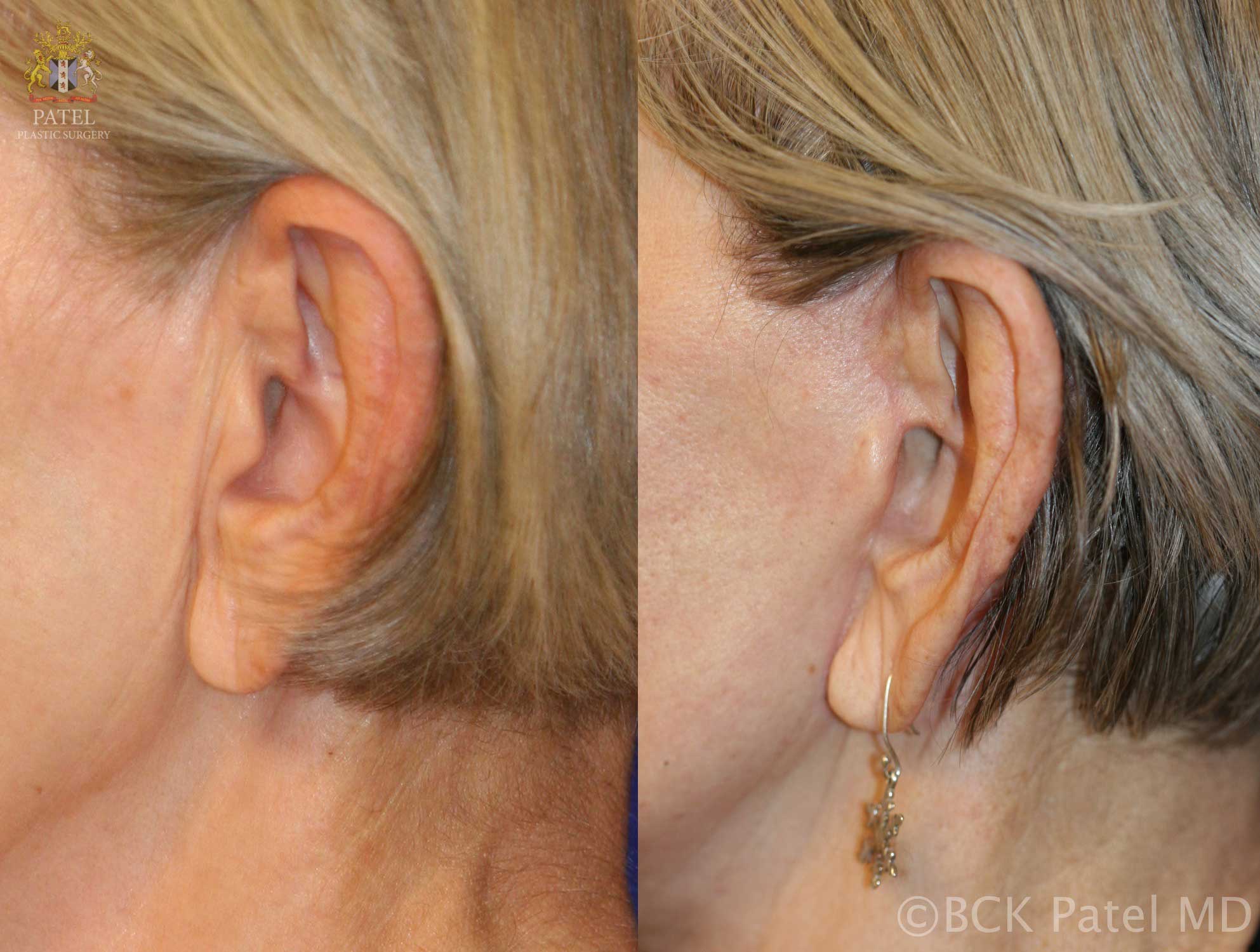
There will also be a small incision below the chin which heals imperceptibly: this allows us access to the neck bands and fat.
For men, the incisions are designed so as to keep the beard hair out of the ear. There are several layers of sutures used, dissolving as well as permanent sutures. The skin sutures are removed between 7 and 14 days after surgery, depending upon a number of factors. In some of our out-of-State and overseas patients, we use the types of sutures that can be left in place longer. We don’t use staples as the final scars from sutures inserted by a skilled surgeon are always superior to mechanical staples. Staples save the surgeon time. Suturing carefully gives you, the patient, superior results!
These procedures can be performed using deep sedation anaesthesia as well as general anaesthesia. Again, we wil look at your general health and previous history and experience with anaesthesia to choose the best level of anaesthesia for you. We work with the best anaesthesiologists who perform superb and properly chosen anaesthesia for our patients.
Patients may choose to have other procedures like endoscopic browlifts, upper and lower blepharoplasty, cheek lifts, fat grafts, laser, lip augmentation and fillers. If you have specific questions or procedures you are considering, we will discuss them with you during your consultation.
Many patients will divide facial cosmetic surgery into a top two-thirds of the face and the lower one-third of the face and the neck. To that end, patients will often choose to have what we call the Hammock Lift, which is a combination of an endoscopic browlift, upper and lower blepharoplasty together with cheek lifts. This essentially gives you a top two-thirds of a facelift. Most of these patients will then have a lower facelift and necklift some months (or years) later. An example of the Hammock Lift is shown to the right: it shows the longevity of the procedures. :
The swelling after facelifts tends to occur on the cheeks and lower down on the face. You will notice that the swelling descends lower down your face over the first few days. It is not uncommon to get bruising around the area below the ears and the neck. It helps to use ice on-and-off on the cheeks and neck for the first two to three days. The bruising and swelling always get worse for the first four days before gradually decreasing. In some patients, the last vestige of bruising or swelling can take several weeks to resolve. Keep the face moisterized with a face moisterizer at least three times a day for the first three weeks.
You will experience tightness of your face as well as numbness of your cheeks. The tightness settles within a few days but the numbness takes a number of months to resolve: this is normal. Most patients are not even aware of this after the first few days. It is not uncommon to need prescription pain medication for the first two to three days, after which most of our patients switch to Tylenol or extra-strength Tylenol.
The neck will feel tight, but this is a good thing as we want to get as much of an improvement in the neck as possible: the neck makes the face! The more elegant the neck, the more gorgeous the face looks.
Please read these guidelines carefully several time prior to your surgery. In the immediate postoperative period of the first few days, there will be swelling, some bruising, you will feel tired, and, it is perfectly normal (and common) for my patients to wonder why they did the surgery! This is only human when the swelling, bruising and limitations compromise your normally active social and work life. I remind all my patients to only think of the results which start to show very quickly and not dwell in the necessary swelling, etc. To that end, it helps to be familiar with the following points:
- Wear loose clothing (a button-up shirt, for example) when you come for your surgery. Your clothes will inevitably get wet because of normal oozing after surgery.
- Make sure someone patient brings you to the surgical center and picks you up. We never hurry our surgeries and will keep you as long as is necessary in the postoperative area to ensure you are well enough to be discharged.
- If you are staying in a hotel, ensure you have several pillows and towels. You will have access to ice. It is best to get a room in a quiet part of the hotel. Let the receptionist know you are having surgery with us: most hotels know us well and will be very helpful. Some will even give you a discounted rate if you let them know that you are having surgery with us! We have listed some of the most convenient hotels in our “out of State and Overseas Patients” section.
- Keep your head elevated using about three pillows for the first three days (and nights). Avoid keeping your neck flexed for prolonged periods of time: this causes prolonged swelling. When bending, bend at the knees. You co not need to remain in bed: a recliner is fine. You may read if you want or watch television.
- Do not take a shower immediately after your surgery. However, you may shower or take a bath after 24 hours: you may shampoo your hair, get your face wet and even use gentle soap on the face and neck. It is perfectly fine to get your sutures wet in the shower.
- We will apply a special velcro-pressure dressing which we will provide you with. We will show you how to apply it back on after a shower and will ask you to wear it every night for the first two weeks and as much as you can during the daytime for two weeks: this helps to reduce swelling and bruising more quickly.
- You may drink water, clear fluids, 7-Up (this drink, when flat, does not make patients suffer from nausea), clear broth, or tea. You may have a light lunch or dinner as long as you are not nauseated (you wil be prescribed medication for nausea if needed). You can resume normal eating and drinking within 24 hours of surgery. It is wise to refrain from imbibing alcohol for the first three days after surgery.
- Apply ice on your face (frozen peas or crushed ice in a glove work well) on-and-off for 20-30 minutes for the first two to three days.
- You will have ointment prescribed to apply to any eyelid incisions. You may apply artificial tears into your eyes as vision often varies as you heal. There is no need to apply any ointment to the incisions around your ears, other than a regular moisterizer.
- Please make sure you have a good moisterizer like Aquaphor, Lubriderm or Eucerin (or any brand you usually use or even Vaseline) as keeping the skin moist, especially if laser has been used, allows the skin to recover more quickly.
- If you have any eyelid surgery performed at the same time, EVERYONE experiences some degree of blurry vision because of swelling and healing: this is normal. Other than using artificial tears and ice as discussed above, there is no reason to worry. The vision reverts back to normal over a few days, but can sometimes take a few weeks!

We have operated on fellow plastic surgeons who are back to work and able to operate within three days. So you may resume work as and when you feel well enough. However, do remember that the body ages over many years and therefore needs some days to a few weeks to heal: we are but mortal!
Pilots who fly commercial planes and commercial lorry drivers generally need three to four weeks before they are safe enough to resume duties.
Office-based work can usually be resumed within a few days if you wish.
Physical work (contractors, builders, painters, etc) will need about 7 – 10 days before they can resume activity, and even then, will have to be careful. 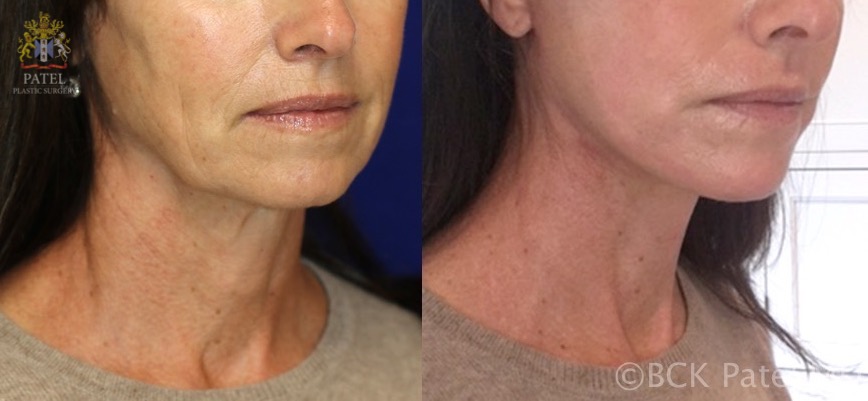
Tennis and skiing are generally best avoided for two weeks. Walking and gentle treadmill workouts can be resumed within three days. Heavy lifting of weights or vigorous aerobic exercize should be avoided for two weeks.
Yoga may be resumed in one week, except for the one-handed tree pose, the wounded peacock pose of the Sayanasana pose: NOT recommended for some weeks, even if you are that amazing that you can perform these poses!
If there are any specific activities you need to know about, kindly ask.
We like to ensure that you are aware of all eventualities and, to that end, kindly ensure you read this section carefully and please ask us any questions you may have prior to surgery. We are always available to go over things again if needed and happy to meet with your family or friends to ensure all questions have been answered.
- Excessive bleeding is a risk. We will insert drains for one to two days if necessary. Remember that we will ask you to stop aspirin, motrin, anti-inflammatory drugs and other such drugs and vitamins that affect blood clotting at least a week prior to surgery. Sometimes, we will insert drains for one to two days if indicated.
- Patients may develop in infection, although this is rare.
- Asymmetry: most of us do not have absolutely symmetrical faces. Indeed, asymmetry of the face is the norm and becomes more obvious as we age. The reason is we all look gorgeous when we are 18 and asymmetries are hidden by the glow of youth! Some of the asymmetry is related to the way we sleep: we call some of the lower facial changes “pillow lines” or “acordian lines”. Other factors that cause asymmetry include familial traits, sun damage, personal habits, etc. As you heal, you WILL see small differences between the right and left sides of the face, especially early in the postoperative period. This is completely normal!
- Scarring of facial incisions is uncommon. Please do not use any anti-scarring tape or gels without permission as they can affect healing.
- Appearance of the face: every one of my patients is concerned about the “pulled look” or the “operated look” which is so disliked. And quite rightly so. We are well-known to never give our patients this type of result. However, as you heal, swelling can temporarily give you more of a pull on one or the other side. As we design the procedure carefully and aim to get as much of a symmetry as possible by the end of the procedure, you should not worry about swelling and temporary asymmetry. Especially in the first few weeks. Everyone experiences this to some extent and is normal.
- As we are working at all the different layers of the face, you will notice that some nerves wake up sooner than others. You may have slight smile asymmetry. Facial nerve weakness or paralysis isa risk of facelift surgery that every surgeon should discuss and disclose to the patient. We endeavour to avoid this by using our extensive anatomical and surgical experience and skills during surgery. But you should always be aware of this risk.
- IMPORTANT: as you will be healing and generally not in circulation with your friends or workmates for the first few days to weeks, it is common to feel “down” and concerned after the surgery. This is very common but it passes. We keep in close touch with our patients, reminding them to keep the old pecker up as things only get better. This response after surgery is nothing abnormal: just us being normal emotional beings.

As we continue to shuffle along this moral coil, what with sun exposure, dryness, wind, natural biological aging, day-to-day wear-and-tear, etc, there will be changes that appear after your facelift and necklift. This will include slowly increasing fine lines or wrinkles, mild depression of facial tissues (as we lose fat with age), gravity-related changes with some loosening of facial tissues, etc. Most of our patients will see us every six months or so: when indicated, in order to maintain the result, we will use filler, lasers, botox, etc as clinic-based treatments to keep the structures firm and youthful. By doing this, we have patients who are many years after their browlifts, belpharoplasties, midface lifts, facelifts and necklifts, who continue to look better than the day before surgery!
- Simple sunscreen and moisterizer use is advisable to protect the skin from the vagaries of heat, dryness, wind and sun.
- Some patients need to improve red spots, broken veins or brown spots which afflict the face for many reasons: these are treated in clinic when the patient wishes to have this improvement using our Advanced Fotofacial and other laser treatments. You can see the types of skin improvement we are talking about in the before-and-after photos under those sections.
- As some deeper loosening invariably occurs, we will use deeper radiofrequency treatments intermittently to keep the appearance as beautiful as we can, without repeat surgery. This is often combined with fillers. Over many years, some patients may need a small procedure which we call a mini-lift.
Years, years and years! Our aim is to re-create Dorian Gray, without the attitude! As Oscar Wilde said, “we have the simplest taste. We are always satisfied by the best.” To that end, my aim is always to perform the best facelift and necklift for you, make you proud, keep your friends guessing, and your enemies jealous.
As discussed above, with the help of minimal maintenance with fillers, lasers and radiofrequency treatments, and appropriate use of suncreen and moisterizer, we can make these results endure for many a year.
As with all the surgeries we perform, but especially with cosmetic procedures, you should remember the following:
- You do NOT need the surgery. You may choose to have it, which is fine.
- Do NOT let anyone convince you that you need to have this surgery. The choice, after being informed of the pros and cons, is yours only.
- This document informs you of most of the important points. However, we encourage you go get other opinions and ask questions. Our job is to perform the very best surgery for you: always read independent testimonials, or talk to our previous patients.
Contact Us
- (801) 413-3599
- info@patelplasticsurgery.com
- (435) 215-0014
- hannah@patelplasticsurgery.com


